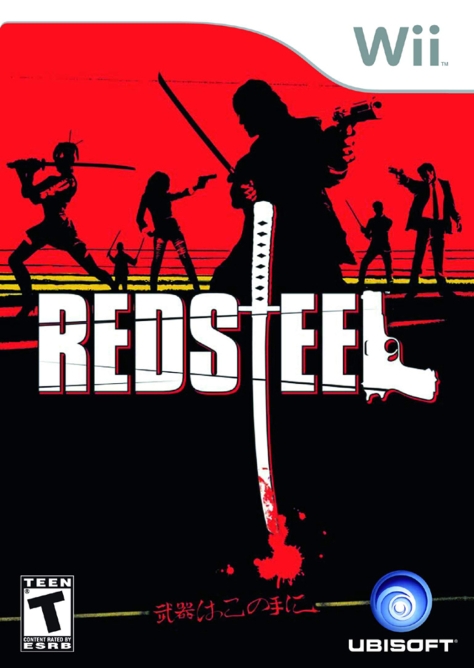
Craving another Wii game following the completion of Kirby’s Epic Yarn, I turned to Red Steel, for some reason. Up until recently I’d never even tried it, but as one of the most publicized games in the lead up to the launch of the Wii, I’ve long been familiar with it. The trailers from that era, with gratuitously animated actors showcasing the capabilities of the system’s unique controller, are hilarious, and Red Steel’s are some of the best. There are a handful of these pre-release trailers floating around, and while they showcased how you interact with the game pretty accurately, they’re just so over the top. When the actors mimic their avatar taking cover by jumping behind furniture themselves, or pause to eat sushi while strolling through a sushi restaurant in game, I mean, c’mon.
This one, apparently from E3 2006, is especially novel now that I’ve completed the game, as it seems like it may be an original proof of concept trailer. First off, the visual fidelity is much too good; richly detailed environments and impressive character animation give off the aura of a pre-rendered trailer rather than actual gameplay. Then there’s the fact the actor is using what appears to prototypes of the Wii Remote and Nunchuk. And, of the scenes portrayed, I believe only one appears in the final product. The three other trailers I’m familiar with were clearly produced closer to the game’s launch, and one of them even serves as the game’s attract mode. They retain the exaggerations of the first trailer, with interstitial gameplay sequences lifted directly from the released game.
In nearly every territory, Red Steel was a launch title for the Wii, which means it first debuted in North America on November 19, 2006, and early December elsewhere. Published by Ubisoft, it was one of seven games they released in the launch window, more than any other publisher; restated, Ubisoft was responsible for almost a quarter of the thirty-two Wii games released to retail by the end of December! Their Paris studio developed this one. Among dozens of other titles developed since their establishment in 1992, this branch spawned the Rayman and Just Dance games, are partially responsible for virtually every Ghost Recon game since Advanced Warfighter, and perhaps most closely aligned with this game, the cel-shaded first-person shooter XIII.
Like many first-person shooters, Red Steel began with a novel in-world reason to look around and get a feel for the controls. My avatar, Scott Monroe, was on a date with his soon-to-be fiancé Miyu Sato, who was pointing out fish in the Los Angeles hotel they were at. Once I had examined the fish of note, they proceeded to their table, where Miyu’s casual banter enlightened me to Scott’s past as her bodyguard, and her apparent status as a socialite. Her father, Isao Sato, the leader of a prominent Yakuza clan in Tokyo, was to join them for dinner. Before Isao and Scott had the opportunity to get properly acquainted though, a rival clan attacked. When all was said and done, Isao suffered mortal injuries and Miyu was taken hostage, and flown back to Tokyo. With the blessing of Isao, Scott took the clan’s heirloom sword, the Katana Giri, and ventured to Japan.

Swordplay may have been a highly touted feature, but first and foremost Red Steel was a first-person shooter. This genre was pretty well suited to the Wii, since aiming with the Wii Remote essentially took over the role of the mouse or right analog stick; the analog stick on the Nunchuk handled movement, just as the left analog stick would on a controller. An on-screen cursor was always present, and “pushing” it to the edge of the screen caused Scott to look in the corresponding direction until I adjusted otherwise; it was an intuitive setup. With little effort, I was booking it through stages and accurately gunning down scores of yakuza foot soldiers using a variety of staple firearms, like shotguns and revolvers. It was actually a lot of fun!
Now, to be fair, forgiving auto-aim was turned on by default. It was easy to miss when using a spray-and-pray gun like an Uzi, but zoomed in with a sniper, I noticed the crosshairs only needed to be near the target to inflict a fatal blow. I didn’t mind, especially since I had to contend with a jittery cursor for most of the game. About every ten seconds, even if I set the Wii Remote down, the cursor would jolt an inch or so and then quickly re-center. This never caused me to die in a gunfight, but like that cricket you just can’t find, it got annoying. I put up with it for two-thirds of the game, chalking it up to a launch game glitch before learning that signal interference from the Wii Remote’s volume might be the culprit! In my case, simply adjusting an in-game sensitivity setting resolved the issue.

Another wonky element exclusive to this unique control scheme was zooming in on targets. With most guns, holding the A button and moving the Wii Remote towards the Sensor Bar caused Scott to look down the barrel of the gun he was holding, or in the case of a sniper rifle, use its telescopic sight. Fundamentally, this action made sense, but imprecision lessened its usefulness. For context, I played the entire game standing up with both hands in front of my stomach, and my arms bent about ninety degrees at the elbows. Sometimes when I tried to zoom in, the game wouldn’t recognize the motion until my arm was fully extended and ironically, it was difficult to be accurate in this awkward position. One of the understated tenets of playing basically anything on the Wii is the utilization of wrist motions instead of full arm movement, and this action made that harder.
Some firearms, like the sniper, had multiple degrees of magnification to contend with. Trying to find the right level of zoom on the invisible Z-axis my Wii Remote occupied was not fun in the middle of a shootout. Unless I had a vantage point or good cover, I’d usually just run up and blast enemies with a shotgun at point blank range. Scott’s health recharged quickly so this was a viable, and satisfying, strategy. Whereas calmly moving the Wii Remote towards the screen triggered one action, thrusting it initiated another: Focus Time. This mechanic froze time and allowed me to select multiple targets; when it ended, Scott eliminated his foes with lightning fast precision. If I had the juice to use it, I could finish gunfights in seconds. Or, as an alternative to outright killing his adversaries, I could target their firearms to deal with them in a nonlethal manner.
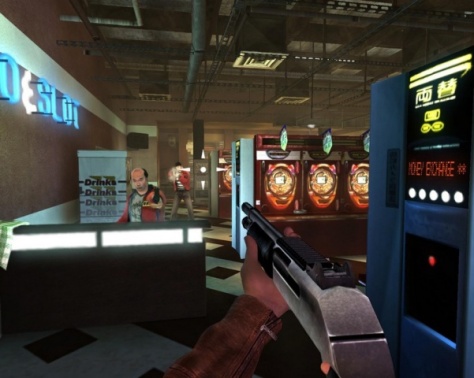
I was given the same sort of spare or kill choice as a finale to nearly every swordfight Scott took part in. This game didn’t feature an overarching morality system like Mass Effect, but I was incentivized to spare foes, as this helped fuel my Focus Time meter, in addition to other methods. Swordfights were a pretty common occurrence and were the only time I used the Katana Giri outside of practice; I’d guess there were about three-dozen over the course of my eight hour playthrough. They sucked. Conceptually, the Wii Remote is a damn near perfect fit for swinging a sword but in practice, at least in this game, it just wasn’t.
Every swordfight was a one-on-one duel. Scott and his opponent locked onto each other, so I didn’t have to worry about positioning. I could dash to the side by holding the C button and moving the analog stick, and this proved to be a prompt, heavily used means of avoiding enemy swings. Alternatively, I could shake the Nunchuk to parry blows with Scott’s tanto. Parrying at the last second left Scott’s adversary open to attack, which was also a great tactic, but not one I could rely upon. Maybe I didn’t grasp the timing window, or maybe my Nunchuk movements were picked up inadvertently, but for whatever reason, I just couldn’t nail these last-second parries. The exception was when an enemy used a powerful charged move, and their blade was illuminated red. This was my sign to dash to the side and parry, damaging their blade in the process. If I damaged their sword enough, it would actually break and end the fight. Enemies got so tough by the last third of the game that I’m pretty sure I won every fight by breaking their sword instead of outright slicing and dicing them.
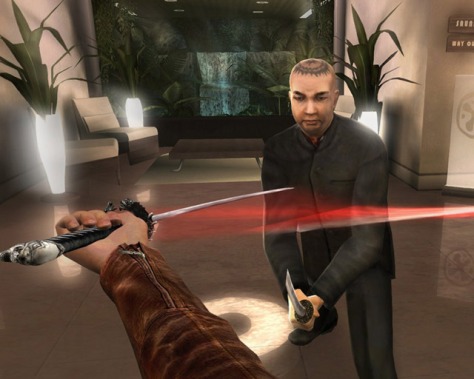
In fact, there were very few clashes that I won by going on the offensive; success came when I was reactive. I could swing the Wii Remote around willy nilly to try and slice Scott’s opponent but almost every attack would get blocked. I tried swinging from different angles (of which the game seemed to register cardinal and intercardinal swings) hoping for an opening, but my attacks often got blocked all the same. Like with the Nunchuk, there were detection issues. Regularly, I’d swing in one direction but my action would be registered differently by the game. There was a setting to switch between swinging movements and wrist motions, and I frequently alternated between the two, but I honestly didn’t notice an improvement. This was an obstacle when trying to perform the few special attack combos Scott learned. These were very strong, but again, I couldn’t reliably pull them off.
The attack on Sato had thrown Tokyo’s seedy underbelly into disarray and Tokai, the rival clan leader responsible, took advantage of the situation. In little time he abducted or coerced the remaining leaders of the Sato clan. Even though Isao entrusted Scott with the Katana Giri, which opened doors with the clan and their associates, he still needed to win over the various factions by rescuing their leadership. These folks were in charge of specific economic activities, like the operation of geisha houses or shipping and receiving. Accordingly, Scott traveled through an assortment of surroundings to save them. These locales made for some interesting stages, even if from a design perspective there wasn’t anything particularly noteworthy; I navigated Scott from point A to point B, engaging enemies in hallways and large open areas, taking cover when appropriate, etc. There was one exception…
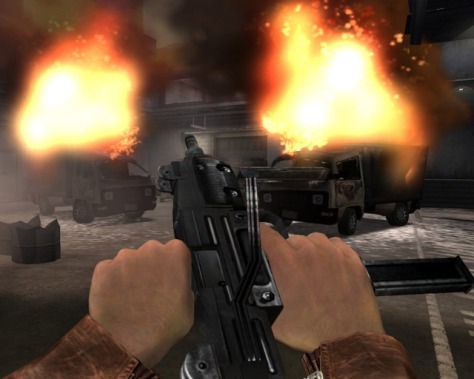
With Sato’s clan falling apart, the leader who managed pachinko parlors lost his marbles, and began orchestrating illegal fights. These fights weren’t what I was expecting though; they were less Fight Club and more Suda51. Instead of back alley brawls against yakuza goons, Scott had to survive a crazed underground theme park. Save for the backdrop, and the occasional amusement ride, it wasn’t really different from the other stages. But, the various sections each had their own ambiance, and it was all just so absurd. In one, Scott had to navigate a series of hallways and rooms to locate the power. The lights were off and it was pitch black, I was hearing all sorts of movement in addition to creepy sound effects and calliope music; it was legitimately creepy! Throughout this stage, Scott was being watched and directed by this guy chiming in through Deadmau5 looking figures, and fending off burly men dressed in school girl uniforms, and the occasional Power Ranger. It was extra.
Freelancer and frequent Ubisoft collaborator Tom Salta composed the game’s score. His work on Red Steel frequently blended traditional Japanese instruments with rock and electronic music. It was a fusion that worked well, especially given the subject matter. The two-dozen or so compositions were diverse not only in their instrumentation, but the themes they invoked, or complemented. Listening back to the soundtrack, unaccompanied from the game, there were really two types of music. One helped to accentuate the ambiance of places, like Angel’s Heaven, a Los Angeles brothel disguised as a massage parlor. The song that played here started as an insidious ambient rock track with faint, sultry feminine moans, before escalating into an up-tempo theme befitting a shootout. There were many of these action-oriented songs, and of them “Patchinko” was the best. This fast-paced electronic rock track featured a female vocalist singing throwaway lyrics in Japanese and English. When it started playing in gunfights, I knew I was in for a good time.

Assuming that first trailer was indeed a proof of concept, I’d say the developers executed their vision, but with mixed results. The concepts shown were brought to life in Red Steel, and the first-person shooting was intuitive and fun. Swordplay on the other hand, was disappointing. Half the time it didn’t seem to register my actions properly, and when it did, I had to contend with frustrating combat. Overall, Red Steel was a decently enjoyable game, with a fun setting, a few memorable set pieces, and novel controls. Take away those motion controls though, and there’d be little reason to look back on an otherwise unremarkable shooter.
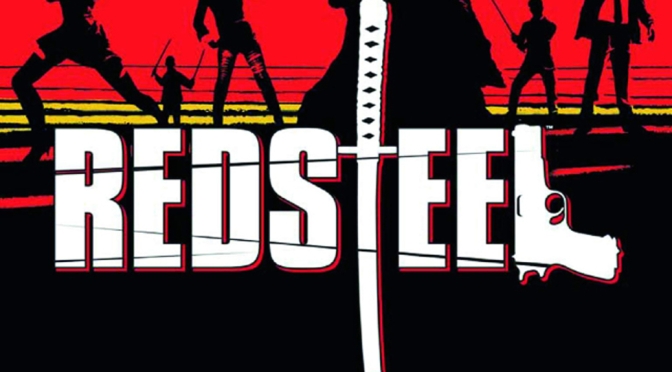
One thought on “Red Steel [Wii] – Review”